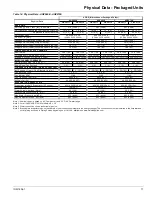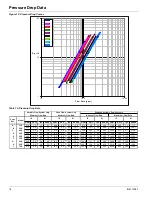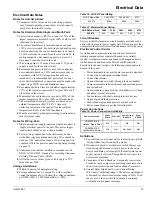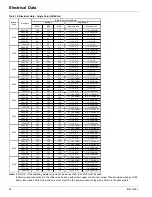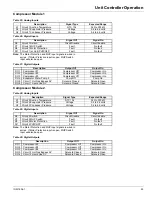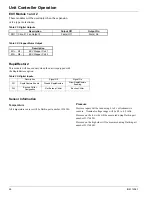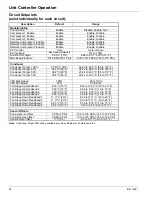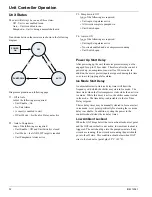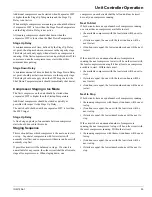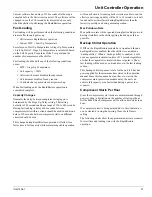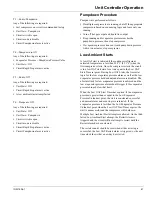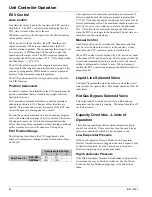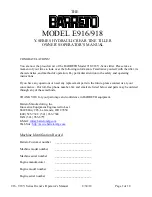
30
IOM 1206-1
Unit Controller Operation
Unit Functions
Definitions
The calculations in this section are used in unit level and
circuit control logic.
LWT Slope
LWT slope is calculated such that the slope represents the
estimated change in LWT over a time frame of one minute.
Pulldown Rate
The slope value calculated above will be a negative value as
the water temperature is dropping. A pulldown rate is
calculated by inverting the slope value and limiting to a
minimum value of 0°C/min.
LWT Error
LWT error is calculated as:
LWT – LWT target
Unit Capacity
For applying unit capacity limits, an estimate of total unit
capacity is needed. Unit capacity will be based on the
estimated circuit capacities.
The unit capacity is the number of compressors running (on
circuits that are not pumping down) divided by the number of
compressors on the unit.
Control Band
The Control Band defines the band in which unit capacity will
not be increased or decreased.
The Control Band is calculated as follows for constant
evaporator flow:
• Four compressor units: Control Band = Nominal Evap
Delta T Set Point * 0.3
• Six compressor units: Control Band = Nominal Evap
Delta T Set Point * 0.2
When Variable Evaporator Flow is required, the control band
increases as capacity decreases to account for the decrease in
flow. It is assumed that the flow will vary to maintain the full
capacity evaporator temperature delta at part load conditions.
The control band is limited at each capacity step to a
maximum value that corresponds to the minimum flow for that
capacity step.
Since evaporator flow is represented by the set point Full
Capacity Evaporator Delta T, the calculations of the control
band for variable flow applications are explained in terms of
delta T also. The term ‘Effective Full Capacity Delta T’ means
the approximate temperature delta that would be observed with
the unit running at full capacity for the given flow. ‘Nominal
flow’ means the flow that is needed for a 5.56°C (10°F) delta
T at full unit capacity.
Table 34: Minimum Flows and Corresponding Maximum
Effective Full Capacity Delta T:
For variable evaporator flow, the Control Band is calculated as
follows:
1
Effective Full Capacity Delta T = (Full Capacity Evap
Delta T* 100) /Unit Capacity
2
If above value is more than the Max Effective Full
Capacity dT listed in the table above for the
corresponding unit capacity, it is set equal to the value in
the table.
3
Effective Full Capacity Delta T with the limit applied is
then multiplied by 0.35 for units with four compressors.
This gives the total control band for the unit
configuration and actual unit capacity.
Staging Temperatures
If the unit is configured for use without glycol:
When the LWT target is more than half the Control Band
above 3.9°C (39.0°F)
• Stage Up Temperature = LWT (Control Band/2)
• Stage Down Temperature = LWT target – (Control Band/
2)
If the LWT target is less than half the Control Band above
3.9°C (39.0°F)
• Stage Down Temperature = LWT target – (LWT target -
3.9°C)
• Stage Up temperature = LWT Control Band –
(LWT target – 3.9°C)
If the unit is configured for use with glycol, the compressor
staging temperatures are calculated as shown below:
• Stage Up Temperature = LWT (Control Band/2)
• Stage Down Temperature = LWT target – (Control Band/
2)
The Start up and Shutdown temperatures are referenced from
the Control Band:
• Start Up Temperature = Stage Up Tempe Start
Up Delta set point
• Shutdown Temperature = Stage Down Temperature –
Shutdown Delta set point
Number of
Compressors
Unit
Capacity
Minimum
Flow
(nominal %)
Max Effective
Full Capacity
DT
4
100%
62.5%
8.9 °C (16 °F)
75%
55%
10.1 °C (18.2 °F)
50%
47.5%
11.7 °C (21.1 °F)
25%
40%
13.9 °C (25 °F)


